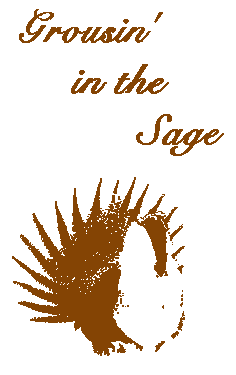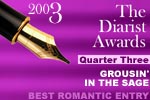






powered by SignMyGuestbook.com

| Newest
Older Previous Next Random Contact Profile Host |
blizzard warnings - 13:52 , 03 October 2013 heelerless - 21:32 , 18 August 2013 Red Coat Inn in Fort McLeod - 11:38 , 23 June 2013 rushing into the waters - 09:53 , 21 June 2013 choosing a spot - 17:43 , 27 April 2013 |
wapiti from heaven
Sunday, everything had worked, except for one, small thing.
No helicopter.
Blocked by storm clouds over the mountains, the bird had been unable to even leave their home town, much less reach our piece of country. Even though the roads were good enough for the fuel truck to arrive safely. So, after recovering a single live elk from the ground, almost all the crew had gone home, most of them back to University Town.
Now it was Monday. The storm had passed, leaving in its wake closed highways. No travel on the interstate, none on the secondary highways. The helicopter, on the other hand, had managed to fly through the river canyon to pass under the cloud cap on the mountains, and was on its way.
So, soon, we would have the chopper, but no veterinarians. All stranded on the other side of closed highways. Not to mention one wrecked his truck on the icy roads the night before. Luckily without injury, but the truck was totalled, and another rig needed to be rounded up to ferry people and gear the 100+ miles to us.
So, there was no one to conduct the necropsies on the two elk the helicopter crew was supposed to shoot and collect. No one to process the three live elk the chopper crew was supposed to netgun and fly back to the old headquarters. No truck and trailer to ferry those live elk back to the laboratory facilities.
But we still had three radio collars that needed to be put on live, healthy elk. With the hope they would allow us to track these herds in the spring, and to learn where most of the dead or dying elk had come from. So we told the chopper pilot to come on down, and we waited. Wondering if he could fly his way through the fog around the Divide, and the airport, to land.
Sometime, when he was less than forty miles away, someone had one of those sudden flashes of insight.
He doesn't need to land at the airport. He can meet us on site, avoiding the foggy Divide completely. I mean, that's why we're paying for fuel truck, right?
So it was a race to the staging area near the winter range.
The helicopter won. But just by seconds.

Someone needed to fly the capture crew and pilot over the area where we expected to find elk. Both healthy ones, and ones down on the ground.
Pointing out the single powerline was high on the flight itinerary, too.
Now, we all know how my stomach enjoys flying. Managed to convince the local warden he was the man for the job, not me. A decision I was particularly grateful for when we noticed the flight crew taking the helicopter apart.
I mean, literally. Grabbing pieces of the whirly-bird, and taking them off. Can't shoot the capture nets out through windows, so the doors have got to come off.
"Which ones?" asks the reluctant volunteer guide.
"All of them," was the answer.
It was a chilly flight.

This bird was a fast one, which was good, i guess, since it was costing in excess of $700 per hour. The orientation flight was over in 13 minutes. The guide and camera man were quickly ejected, and the gunner and two muggers ("muggers": a New Zealand term, where this form of capturing big game was developed, for the guys who jump out of the hovering aircraft to wrestle the netted animal down and subdue it) quickly loaded up.
Twelve minutes later they were airborne, the gunner hanging out one door by his safety strap.

And then we waited.
And waited.
Finally, one warden could stand it no more, and disappeared on a four-wheeler to look for a wayward water sampler who had failed to return, and had not checked in by radio. A little bit later, a second warden took off after the first, who also had failed to return. Finally the boss, who was ramrodding this whole deal, drove off in his rig to look for the lost wardens.
I stayed on alert, alone with the video crew, waiting for the chopper. When I saw the boss's rig spin a doughnut turning around on the far ridgetop, throwing plumes of snow out the back, I knew the bird was on the way. Hopefully with a dead elk hanging below.
It had two.
We quickly stripped the warm carcasses out of their slings, which were loaded back into the chopper.
And then we waited. The lost wardens and water sampler finally returned, with an ATV with a flat tire.
And we waited some more. I figured ten minutes out to find an elk that is down with this mysterious malady, ten minutes to load it in the sling, alive, and ten minutes to bring it back.
Thirty minutes passed, and no helicopter.
Thirty-five minutes, and no whirly bird.
Thirty-nine minutes after he left, the pilot returns. With not one, not two, but with all three live elk flying below his carriage.

These he gently sets on the ground, and then releases the cable. We in the ground crew quickly charge in and get the three elk set upright on their briskets.
One of them is a spike. A yearling male with bony daggers on his head. Which are handy for steering him around, but also ended up poking the neighboring cow in the butt more than once.
The pilot flies off to retrieve his three-man crew. They return shortly, having also radio-collared three healthy elk. In less than an hour they have replaced the four doors, gathered their gear, said their goodbyes, and taken off for home.
For the three elk, the next few hours are like anyone else's visit to the emergency room.
First you have to wait for the doctors.

Who, in this case, have been on the recently opened interstate for less than an hour, and won't arrive for another hour more.
Once all the veterinary crew shows up, things start happening fast.
Like any hospital visit, the first thing each patient gets is an identification bracelet.

And like any doctor's visit, they take your vitals, such as temperature (this one was 103.1). And yeah, they take it that way.

Then there are the usual blood samples taken.

And the usual injections.

In this case, each elk got a shot of penicillin. Basically insurance against any opportunistic infections that might arise after the animal is put in so much stress during capture. And they each got a shot of a different vitamin, in the hope a positive response in at least one of them might provide a clue as to the cause of their affliction.
And then each was given at least a liter of intravenous saline solution, presuming they had become dehydrated while they were down.

Soon there were three folks from our outfit, friends of mine, standing there, each holding an IV bag connected to a living elk. The IV bags tucked up under their coats to keep the saline solution warm.
Three people who have dedicated their lives to the protection of these animals, standing there imparting some of their personal life energy, in the form of heat, directly into the body of one of their wild charges.

Yeah, I was envious.
Me, I was moving around, lifting elk heads and stretching their necks, pressing down on the muscles to make the veins easier for the vets to find. Or shifting hobbled hooves into more comfortable, safer positions. Securing the wayward spike antlers.
And shooting photos with a free hand when I could.
Somewhere in the process, I found myself with an ungulate in my lap again, its hot breath warming my knees.

When all the IVs were drained, it was time to load the elk for transport. One by one, a tarp was slid under each elk, then it was lifted and carried, stretcher-style, into the waiting horse trailer.
But the third elk required one more, final surgical procedure.
Removal of the young bull's dangerous spikes.

Yet another use for a handy Leatherman tool.
After a lot of manual labor, the three elk were settled in a bed of warm straw. The young bull glaring at us through his blindfold, apparently well aware we had removed his male boasting rights.

Now, the official transport from University Town had never arrived, stranded behind some closed secondary highway. This was the personal trailer of a local warden, commandeered for this project. So he and I headed for University Town, 112 miles away.
And delivered the three elk to their new homes.

No longer free, but certainly warmer and safer, with food and water. And hopefully to provide the vets with some answers about what has taken away the use of their legs. (Which they could still feel and kick with. Figure that out.)
We treated ourselves to steak dinners at Applebies, and headed home after sunset.